Leadership Competency Improvement Report for LDRS 697 Course
VerifiedAdded on 2022/09/01
|9
|2379
|19
Report
AI Summary
This report examines leadership competency improvement, focusing on transformational and servant leadership within a competitive market context. It begins with a case study analysis and a review of relevant literature, including works on organizational integrity, ethical leadership, and entrepreneurial vision. The report analyzes the case through the lens of transformational servant leadership, emphasizing values and ethics, and higher-order thinking. It synthesizes best practices from evidence-based investigations and problem-solving, and reflects on implications for personal action, including knowledge of self, needs of others, and organizational objectives. The report concludes with a personal action plan for future implementation, aimed at enhancing leadership capabilities in a dynamic business environment. Key themes include the importance of values, ethics, and the role of leaders in fostering employee development and organizational success.
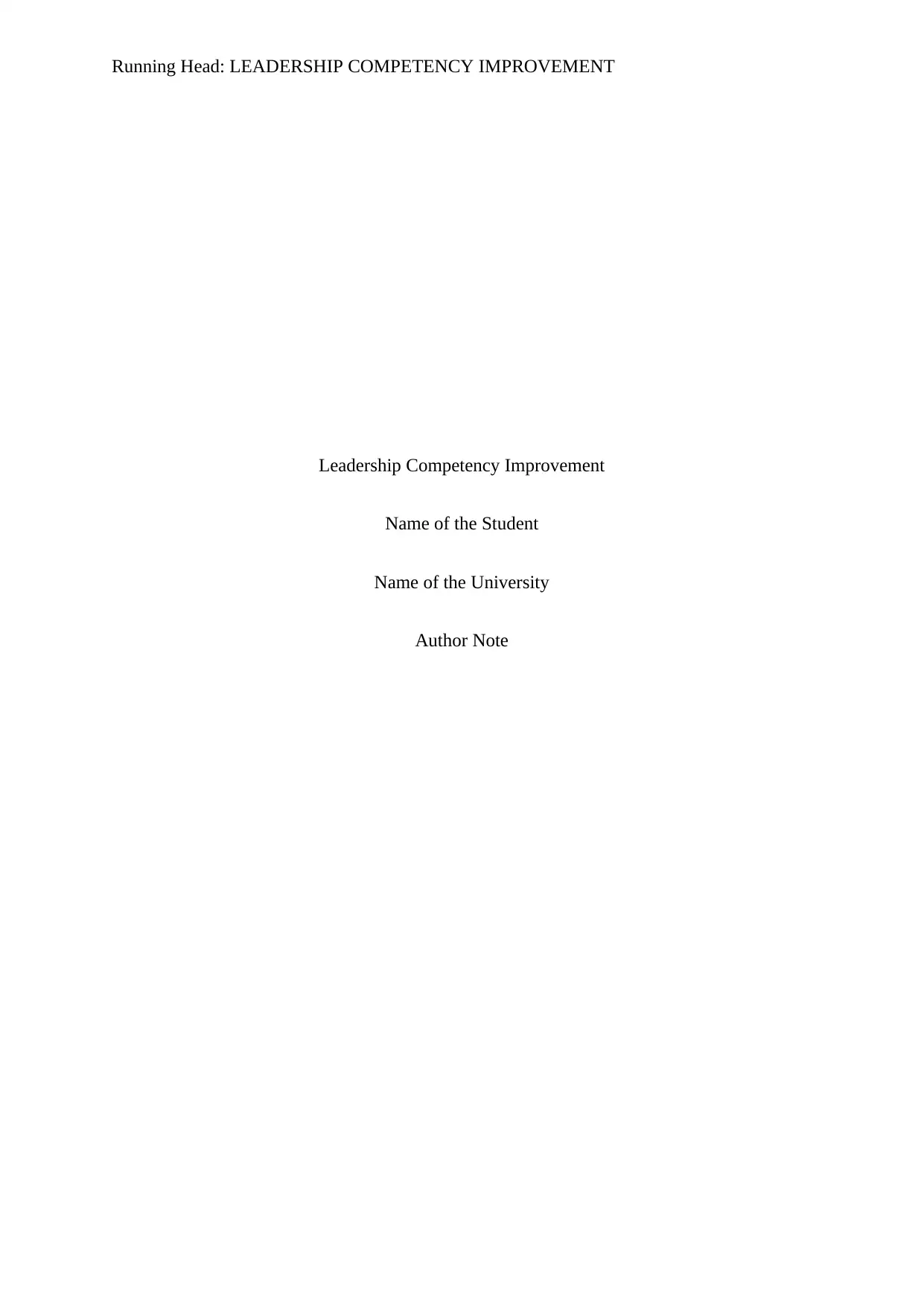
Running Head: LEADERSHIP COMPETENCY IMPROVEMENT
Leadership Competency Improvement
Name of the Student
Name of the University
Author Note
Leadership Competency Improvement
Name of the Student
Name of the University
Author Note
Paraphrase This Document
Need a fresh take? Get an instant paraphrase of this document with our AI Paraphraser
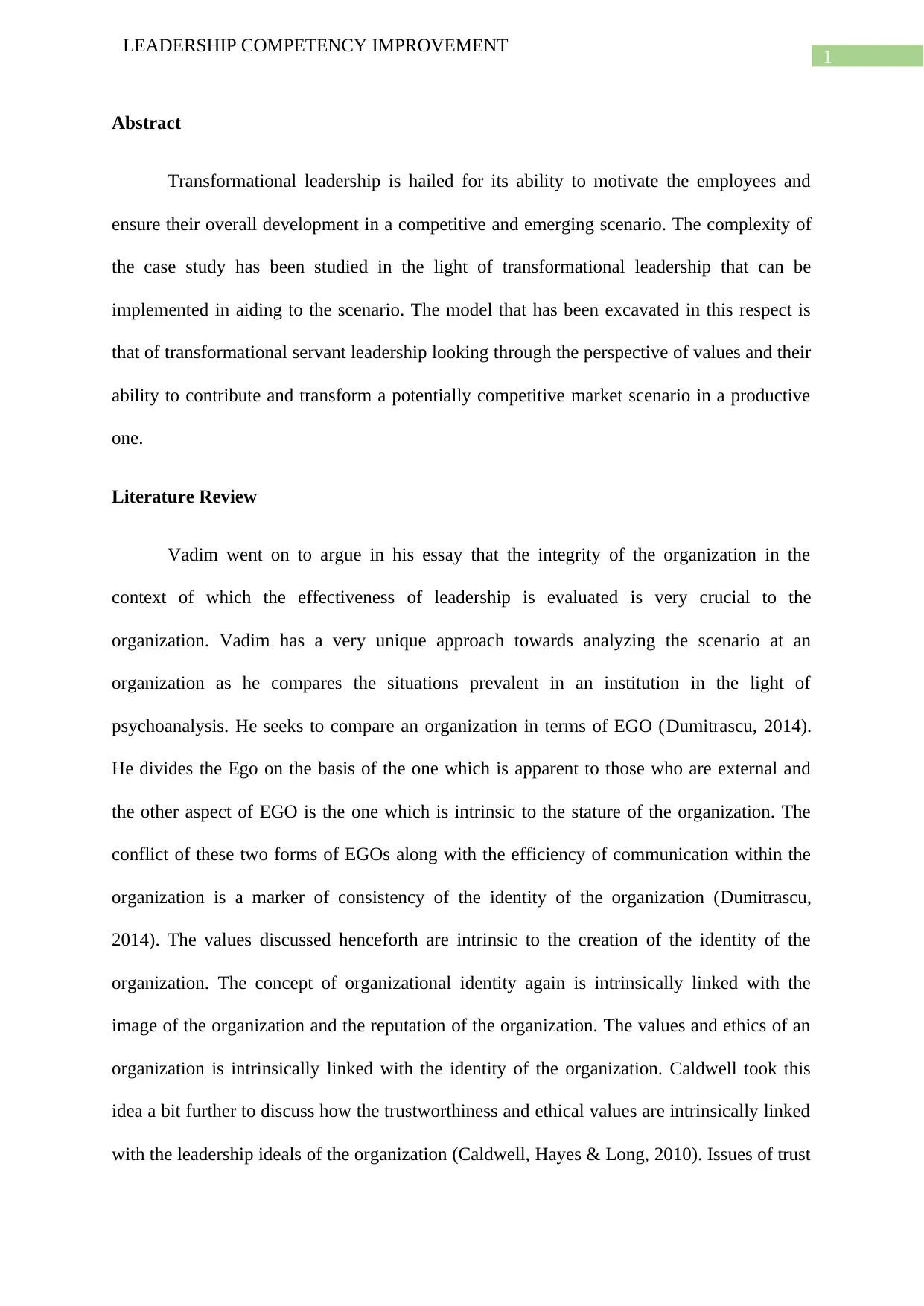
1
LEADERSHIP COMPETENCY IMPROVEMENT
Abstract
Transformational leadership is hailed for its ability to motivate the employees and
ensure their overall development in a competitive and emerging scenario. The complexity of
the case study has been studied in the light of transformational leadership that can be
implemented in aiding to the scenario. The model that has been excavated in this respect is
that of transformational servant leadership looking through the perspective of values and their
ability to contribute and transform a potentially competitive market scenario in a productive
one.
Literature Review
Vadim went on to argue in his essay that the integrity of the organization in the
context of which the effectiveness of leadership is evaluated is very crucial to the
organization. Vadim has a very unique approach towards analyzing the scenario at an
organization as he compares the situations prevalent in an institution in the light of
psychoanalysis. He seeks to compare an organization in terms of EGO (Dumitrascu, 2014).
He divides the Ego on the basis of the one which is apparent to those who are external and
the other aspect of EGO is the one which is intrinsic to the stature of the organization. The
conflict of these two forms of EGOs along with the efficiency of communication within the
organization is a marker of consistency of the identity of the organization (Dumitrascu,
2014). The values discussed henceforth are intrinsic to the creation of the identity of the
organization. The concept of organizational identity again is intrinsically linked with the
image of the organization and the reputation of the organization. The values and ethics of an
organization is intrinsically linked with the identity of the organization. Caldwell took this
idea a bit further to discuss how the trustworthiness and ethical values are intrinsically linked
with the leadership ideals of the organization (Caldwell, Hayes & Long, 2010). Issues of trust
LEADERSHIP COMPETENCY IMPROVEMENT
Abstract
Transformational leadership is hailed for its ability to motivate the employees and
ensure their overall development in a competitive and emerging scenario. The complexity of
the case study has been studied in the light of transformational leadership that can be
implemented in aiding to the scenario. The model that has been excavated in this respect is
that of transformational servant leadership looking through the perspective of values and their
ability to contribute and transform a potentially competitive market scenario in a productive
one.
Literature Review
Vadim went on to argue in his essay that the integrity of the organization in the
context of which the effectiveness of leadership is evaluated is very crucial to the
organization. Vadim has a very unique approach towards analyzing the scenario at an
organization as he compares the situations prevalent in an institution in the light of
psychoanalysis. He seeks to compare an organization in terms of EGO (Dumitrascu, 2014).
He divides the Ego on the basis of the one which is apparent to those who are external and
the other aspect of EGO is the one which is intrinsic to the stature of the organization. The
conflict of these two forms of EGOs along with the efficiency of communication within the
organization is a marker of consistency of the identity of the organization (Dumitrascu,
2014). The values discussed henceforth are intrinsic to the creation of the identity of the
organization. The concept of organizational identity again is intrinsically linked with the
image of the organization and the reputation of the organization. The values and ethics of an
organization is intrinsically linked with the identity of the organization. Caldwell took this
idea a bit further to discuss how the trustworthiness and ethical values are intrinsically linked
with the leadership ideals of the organization (Caldwell, Hayes & Long, 2010). Issues of trust
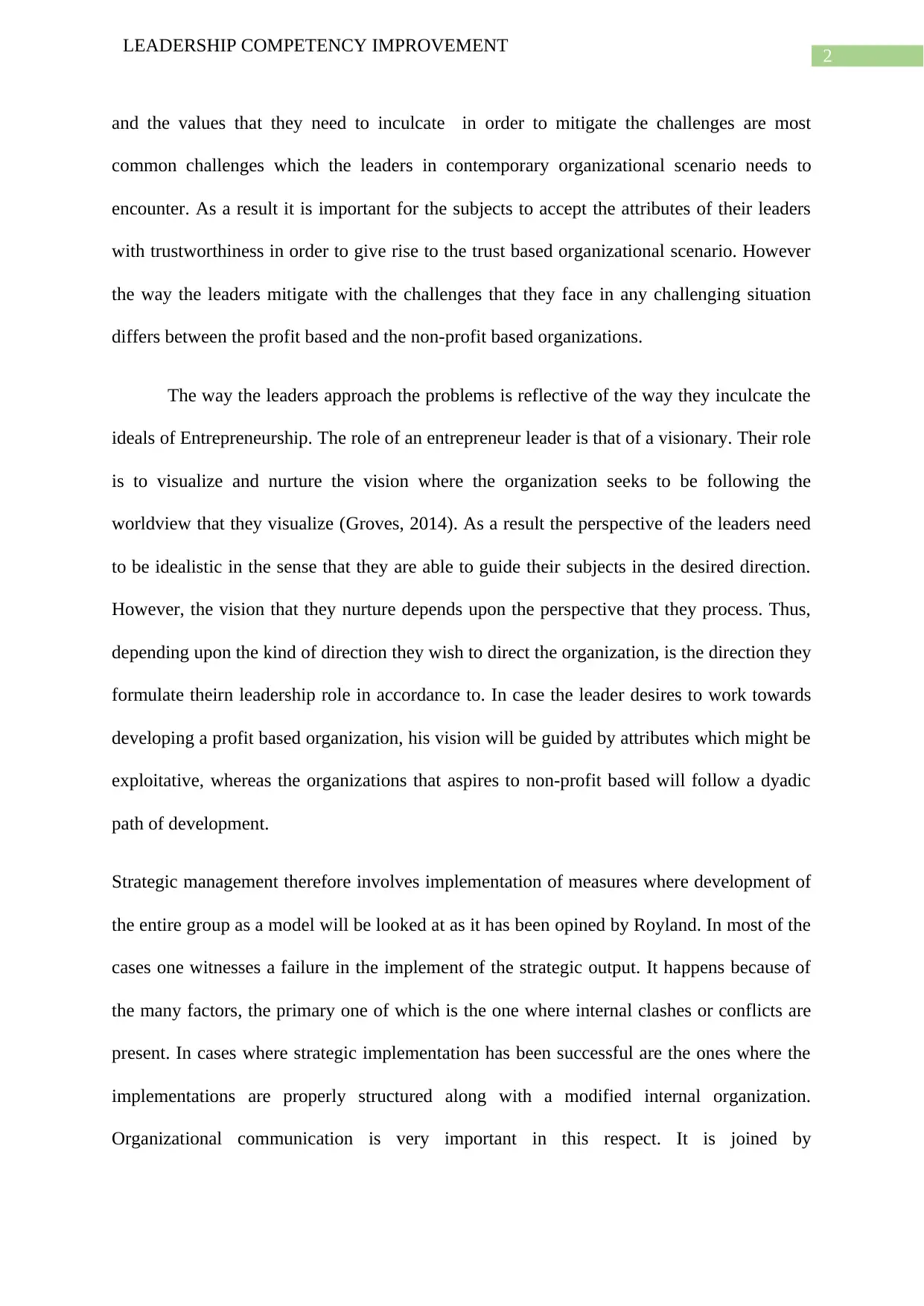
2
LEADERSHIP COMPETENCY IMPROVEMENT
and the values that they need to inculcate in order to mitigate the challenges are most
common challenges which the leaders in contemporary organizational scenario needs to
encounter. As a result it is important for the subjects to accept the attributes of their leaders
with trustworthiness in order to give rise to the trust based organizational scenario. However
the way the leaders mitigate with the challenges that they face in any challenging situation
differs between the profit based and the non-profit based organizations.
The way the leaders approach the problems is reflective of the way they inculcate the
ideals of Entrepreneurship. The role of an entrepreneur leader is that of a visionary. Their role
is to visualize and nurture the vision where the organization seeks to be following the
worldview that they visualize (Groves, 2014). As a result the perspective of the leaders need
to be idealistic in the sense that they are able to guide their subjects in the desired direction.
However, the vision that they nurture depends upon the perspective that they process. Thus,
depending upon the kind of direction they wish to direct the organization, is the direction they
formulate theirn leadership role in accordance to. In case the leader desires to work towards
developing a profit based organization, his vision will be guided by attributes which might be
exploitative, whereas the organizations that aspires to non-profit based will follow a dyadic
path of development.
Strategic management therefore involves implementation of measures where development of
the entire group as a model will be looked at as it has been opined by Royland. In most of the
cases one witnesses a failure in the implement of the strategic output. It happens because of
the many factors, the primary one of which is the one where internal clashes or conflicts are
present. In cases where strategic implementation has been successful are the ones where the
implementations are properly structured along with a modified internal organization.
Organizational communication is very important in this respect. It is joined by
LEADERSHIP COMPETENCY IMPROVEMENT
and the values that they need to inculcate in order to mitigate the challenges are most
common challenges which the leaders in contemporary organizational scenario needs to
encounter. As a result it is important for the subjects to accept the attributes of their leaders
with trustworthiness in order to give rise to the trust based organizational scenario. However
the way the leaders mitigate with the challenges that they face in any challenging situation
differs between the profit based and the non-profit based organizations.
The way the leaders approach the problems is reflective of the way they inculcate the
ideals of Entrepreneurship. The role of an entrepreneur leader is that of a visionary. Their role
is to visualize and nurture the vision where the organization seeks to be following the
worldview that they visualize (Groves, 2014). As a result the perspective of the leaders need
to be idealistic in the sense that they are able to guide their subjects in the desired direction.
However, the vision that they nurture depends upon the perspective that they process. Thus,
depending upon the kind of direction they wish to direct the organization, is the direction they
formulate theirn leadership role in accordance to. In case the leader desires to work towards
developing a profit based organization, his vision will be guided by attributes which might be
exploitative, whereas the organizations that aspires to non-profit based will follow a dyadic
path of development.
Strategic management therefore involves implementation of measures where development of
the entire group as a model will be looked at as it has been opined by Royland. In most of the
cases one witnesses a failure in the implement of the strategic output. It happens because of
the many factors, the primary one of which is the one where internal clashes or conflicts are
present. In cases where strategic implementation has been successful are the ones where the
implementations are properly structured along with a modified internal organization.
Organizational communication is very important in this respect. It is joined by
⊘ This is a preview!⊘
Do you want full access?
Subscribe today to unlock all pages.

Trusted by 1+ million students worldwide
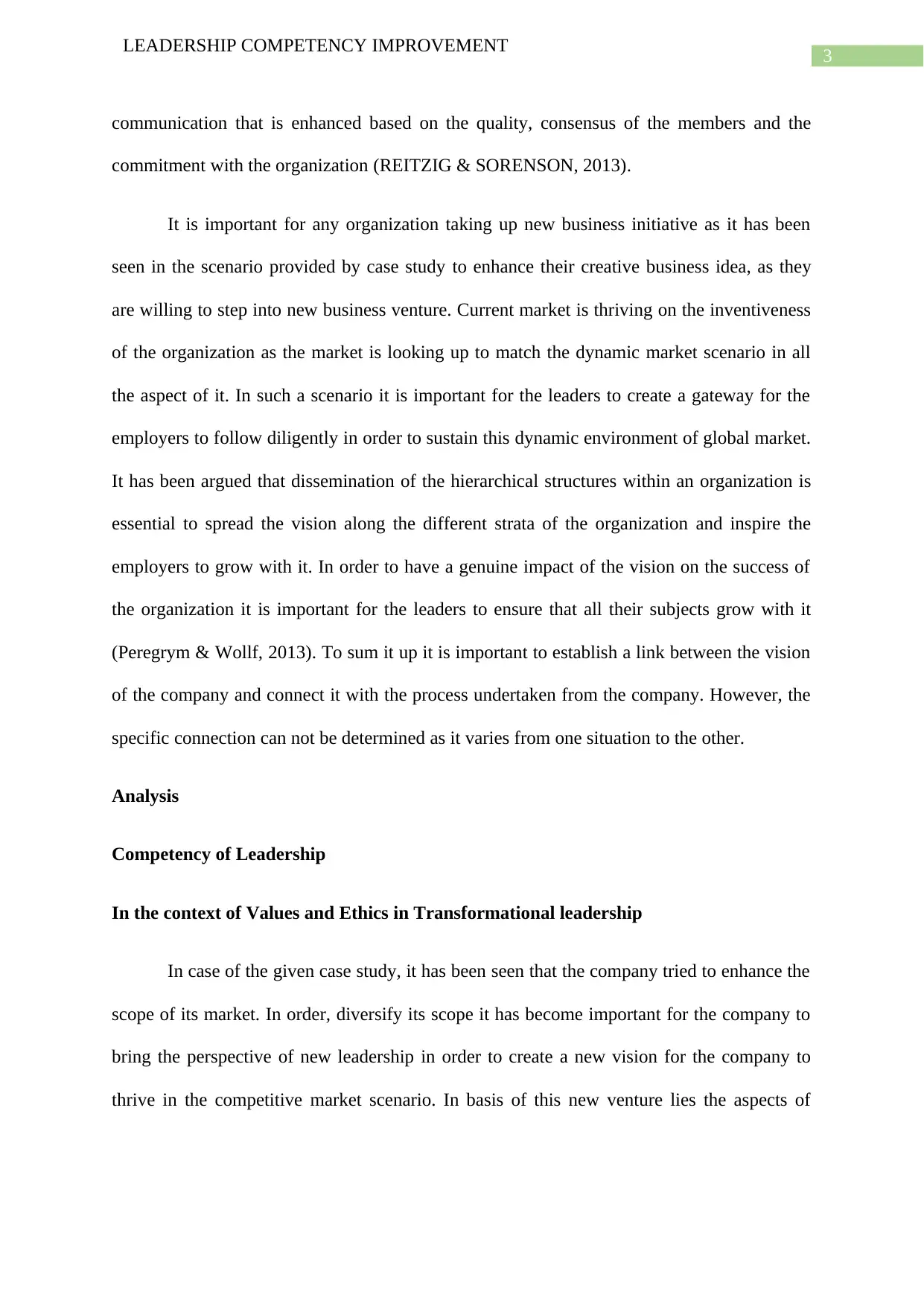
3
LEADERSHIP COMPETENCY IMPROVEMENT
communication that is enhanced based on the quality, consensus of the members and the
commitment with the organization (REITZIG & SORENSON, 2013).
It is important for any organization taking up new business initiative as it has been
seen in the scenario provided by case study to enhance their creative business idea, as they
are willing to step into new business venture. Current market is thriving on the inventiveness
of the organization as the market is looking up to match the dynamic market scenario in all
the aspect of it. In such a scenario it is important for the leaders to create a gateway for the
employers to follow diligently in order to sustain this dynamic environment of global market.
It has been argued that dissemination of the hierarchical structures within an organization is
essential to spread the vision along the different strata of the organization and inspire the
employers to grow with it. In order to have a genuine impact of the vision on the success of
the organization it is important for the leaders to ensure that all their subjects grow with it
(Peregrym & Wollf, 2013). To sum it up it is important to establish a link between the vision
of the company and connect it with the process undertaken from the company. However, the
specific connection can not be determined as it varies from one situation to the other.
Analysis
Competency of Leadership
In the context of Values and Ethics in Transformational leadership
In case of the given case study, it has been seen that the company tried to enhance the
scope of its market. In order, diversify its scope it has become important for the company to
bring the perspective of new leadership in order to create a new vision for the company to
thrive in the competitive market scenario. In basis of this new venture lies the aspects of
LEADERSHIP COMPETENCY IMPROVEMENT
communication that is enhanced based on the quality, consensus of the members and the
commitment with the organization (REITZIG & SORENSON, 2013).
It is important for any organization taking up new business initiative as it has been
seen in the scenario provided by case study to enhance their creative business idea, as they
are willing to step into new business venture. Current market is thriving on the inventiveness
of the organization as the market is looking up to match the dynamic market scenario in all
the aspect of it. In such a scenario it is important for the leaders to create a gateway for the
employers to follow diligently in order to sustain this dynamic environment of global market.
It has been argued that dissemination of the hierarchical structures within an organization is
essential to spread the vision along the different strata of the organization and inspire the
employers to grow with it. In order to have a genuine impact of the vision on the success of
the organization it is important for the leaders to ensure that all their subjects grow with it
(Peregrym & Wollf, 2013). To sum it up it is important to establish a link between the vision
of the company and connect it with the process undertaken from the company. However, the
specific connection can not be determined as it varies from one situation to the other.
Analysis
Competency of Leadership
In the context of Values and Ethics in Transformational leadership
In case of the given case study, it has been seen that the company tried to enhance the
scope of its market. In order, diversify its scope it has become important for the company to
bring the perspective of new leadership in order to create a new vision for the company to
thrive in the competitive market scenario. In basis of this new venture lies the aspects of
Paraphrase This Document
Need a fresh take? Get an instant paraphrase of this document with our AI Paraphraser
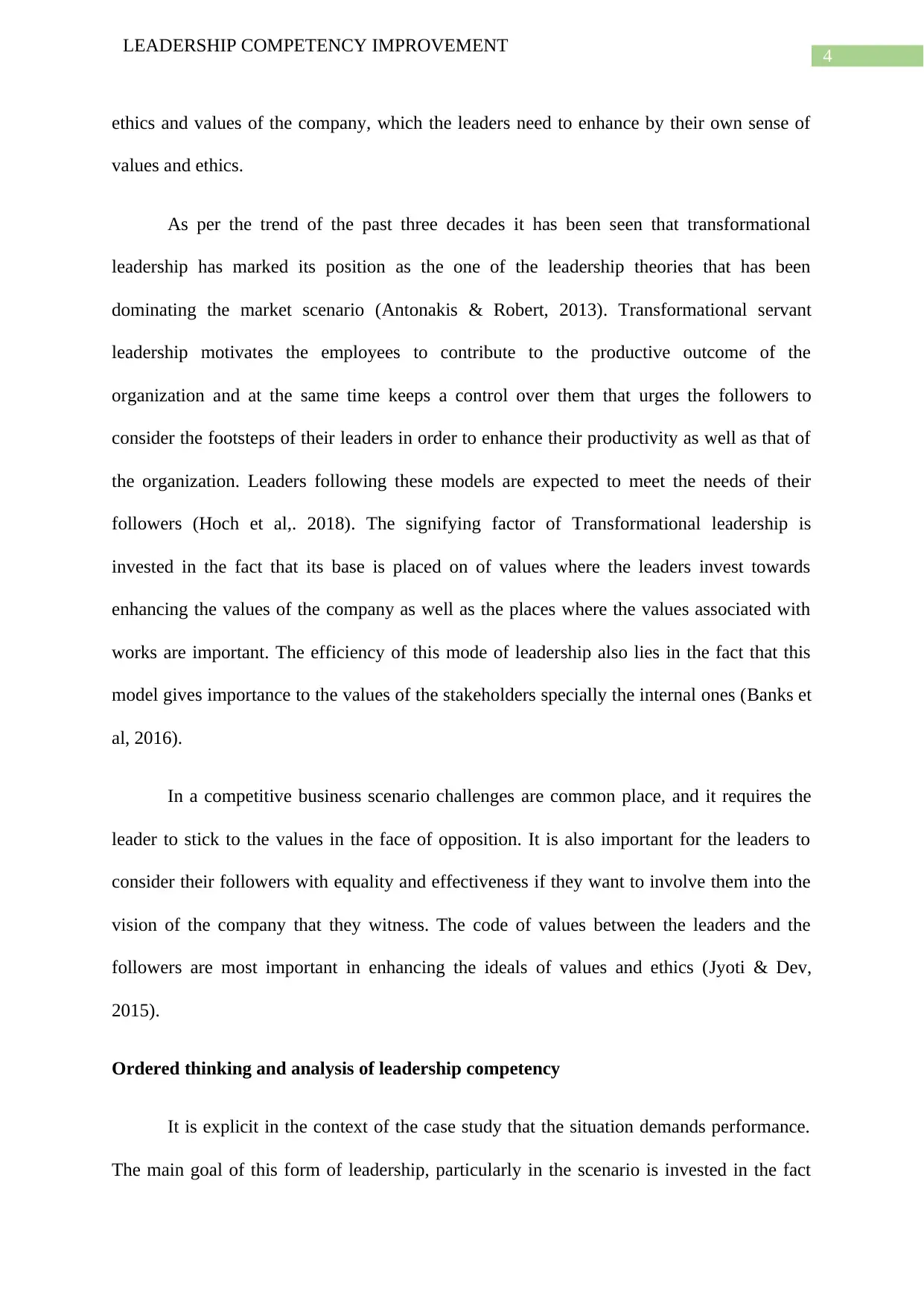
4
LEADERSHIP COMPETENCY IMPROVEMENT
ethics and values of the company, which the leaders need to enhance by their own sense of
values and ethics.
As per the trend of the past three decades it has been seen that transformational
leadership has marked its position as the one of the leadership theories that has been
dominating the market scenario (Antonakis & Robert, 2013). Transformational servant
leadership motivates the employees to contribute to the productive outcome of the
organization and at the same time keeps a control over them that urges the followers to
consider the footsteps of their leaders in order to enhance their productivity as well as that of
the organization. Leaders following these models are expected to meet the needs of their
followers (Hoch et al,. 2018). The signifying factor of Transformational leadership is
invested in the fact that its base is placed on of values where the leaders invest towards
enhancing the values of the company as well as the places where the values associated with
works are important. The efficiency of this mode of leadership also lies in the fact that this
model gives importance to the values of the stakeholders specially the internal ones (Banks et
al, 2016).
In a competitive business scenario challenges are common place, and it requires the
leader to stick to the values in the face of opposition. It is also important for the leaders to
consider their followers with equality and effectiveness if they want to involve them into the
vision of the company that they witness. The code of values between the leaders and the
followers are most important in enhancing the ideals of values and ethics (Jyoti & Dev,
2015).
Ordered thinking and analysis of leadership competency
It is explicit in the context of the case study that the situation demands performance.
The main goal of this form of leadership, particularly in the scenario is invested in the fact
LEADERSHIP COMPETENCY IMPROVEMENT
ethics and values of the company, which the leaders need to enhance by their own sense of
values and ethics.
As per the trend of the past three decades it has been seen that transformational
leadership has marked its position as the one of the leadership theories that has been
dominating the market scenario (Antonakis & Robert, 2013). Transformational servant
leadership motivates the employees to contribute to the productive outcome of the
organization and at the same time keeps a control over them that urges the followers to
consider the footsteps of their leaders in order to enhance their productivity as well as that of
the organization. Leaders following these models are expected to meet the needs of their
followers (Hoch et al,. 2018). The signifying factor of Transformational leadership is
invested in the fact that its base is placed on of values where the leaders invest towards
enhancing the values of the company as well as the places where the values associated with
works are important. The efficiency of this mode of leadership also lies in the fact that this
model gives importance to the values of the stakeholders specially the internal ones (Banks et
al, 2016).
In a competitive business scenario challenges are common place, and it requires the
leader to stick to the values in the face of opposition. It is also important for the leaders to
consider their followers with equality and effectiveness if they want to involve them into the
vision of the company that they witness. The code of values between the leaders and the
followers are most important in enhancing the ideals of values and ethics (Jyoti & Dev,
2015).
Ordered thinking and analysis of leadership competency
It is explicit in the context of the case study that the situation demands performance.
The main goal of this form of leadership, particularly in the scenario is invested in the fact
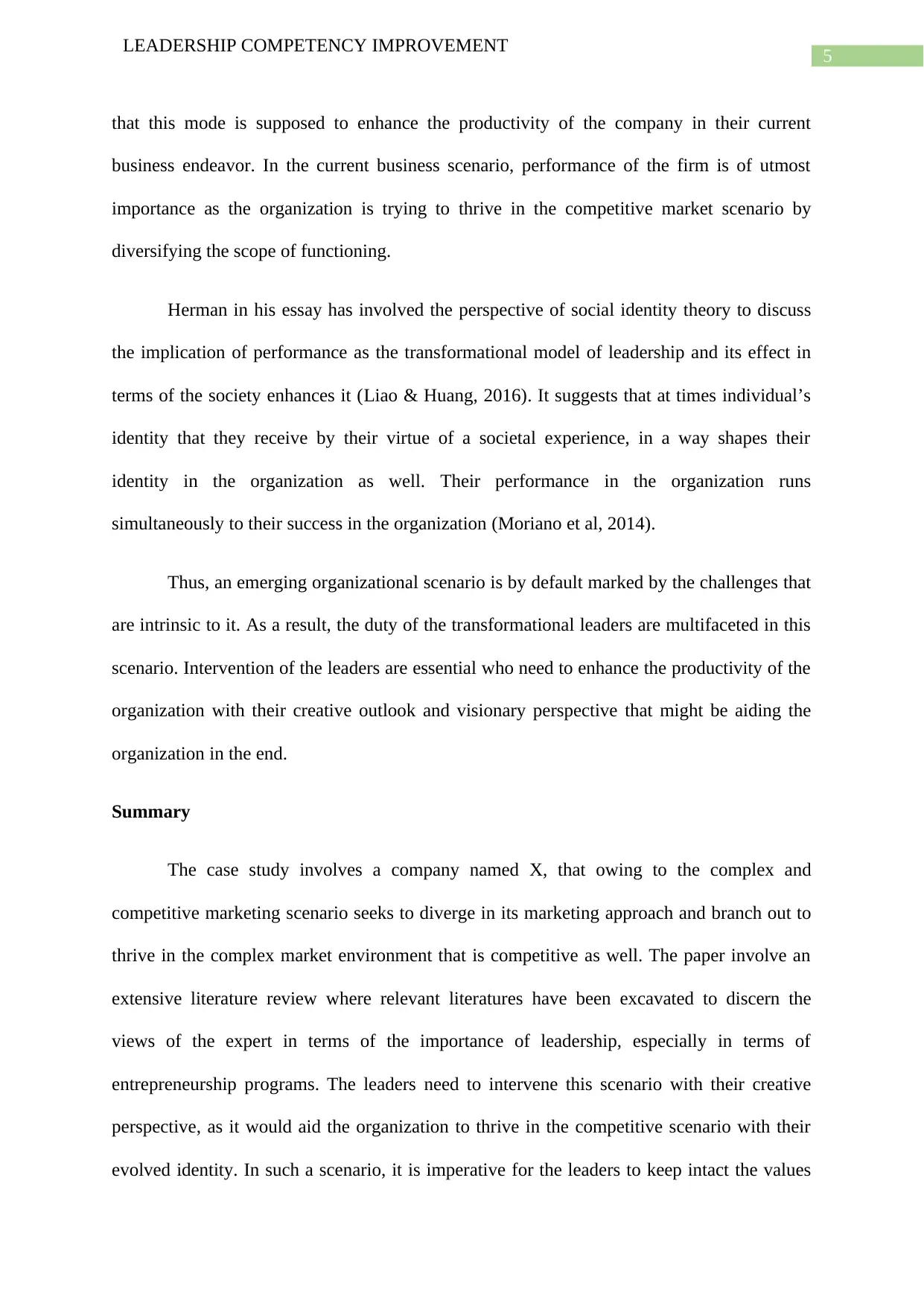
5
LEADERSHIP COMPETENCY IMPROVEMENT
that this mode is supposed to enhance the productivity of the company in their current
business endeavor. In the current business scenario, performance of the firm is of utmost
importance as the organization is trying to thrive in the competitive market scenario by
diversifying the scope of functioning.
Herman in his essay has involved the perspective of social identity theory to discuss
the implication of performance as the transformational model of leadership and its effect in
terms of the society enhances it (Liao & Huang, 2016). It suggests that at times individual’s
identity that they receive by their virtue of a societal experience, in a way shapes their
identity in the organization as well. Their performance in the organization runs
simultaneously to their success in the organization (Moriano et al, 2014).
Thus, an emerging organizational scenario is by default marked by the challenges that
are intrinsic to it. As a result, the duty of the transformational leaders are multifaceted in this
scenario. Intervention of the leaders are essential who need to enhance the productivity of the
organization with their creative outlook and visionary perspective that might be aiding the
organization in the end.
Summary
The case study involves a company named X, that owing to the complex and
competitive marketing scenario seeks to diverge in its marketing approach and branch out to
thrive in the complex market environment that is competitive as well. The paper involve an
extensive literature review where relevant literatures have been excavated to discern the
views of the expert in terms of the importance of leadership, especially in terms of
entrepreneurship programs. The leaders need to intervene this scenario with their creative
perspective, as it would aid the organization to thrive in the competitive scenario with their
evolved identity. In such a scenario, it is imperative for the leaders to keep intact the values
LEADERSHIP COMPETENCY IMPROVEMENT
that this mode is supposed to enhance the productivity of the company in their current
business endeavor. In the current business scenario, performance of the firm is of utmost
importance as the organization is trying to thrive in the competitive market scenario by
diversifying the scope of functioning.
Herman in his essay has involved the perspective of social identity theory to discuss
the implication of performance as the transformational model of leadership and its effect in
terms of the society enhances it (Liao & Huang, 2016). It suggests that at times individual’s
identity that they receive by their virtue of a societal experience, in a way shapes their
identity in the organization as well. Their performance in the organization runs
simultaneously to their success in the organization (Moriano et al, 2014).
Thus, an emerging organizational scenario is by default marked by the challenges that
are intrinsic to it. As a result, the duty of the transformational leaders are multifaceted in this
scenario. Intervention of the leaders are essential who need to enhance the productivity of the
organization with their creative outlook and visionary perspective that might be aiding the
organization in the end.
Summary
The case study involves a company named X, that owing to the complex and
competitive marketing scenario seeks to diverge in its marketing approach and branch out to
thrive in the complex market environment that is competitive as well. The paper involve an
extensive literature review where relevant literatures have been excavated to discern the
views of the expert in terms of the importance of leadership, especially in terms of
entrepreneurship programs. The leaders need to intervene this scenario with their creative
perspective, as it would aid the organization to thrive in the competitive scenario with their
evolved identity. In such a scenario, it is imperative for the leaders to keep intact the values
⊘ This is a preview!⊘
Do you want full access?
Subscribe today to unlock all pages.

Trusted by 1+ million students worldwide
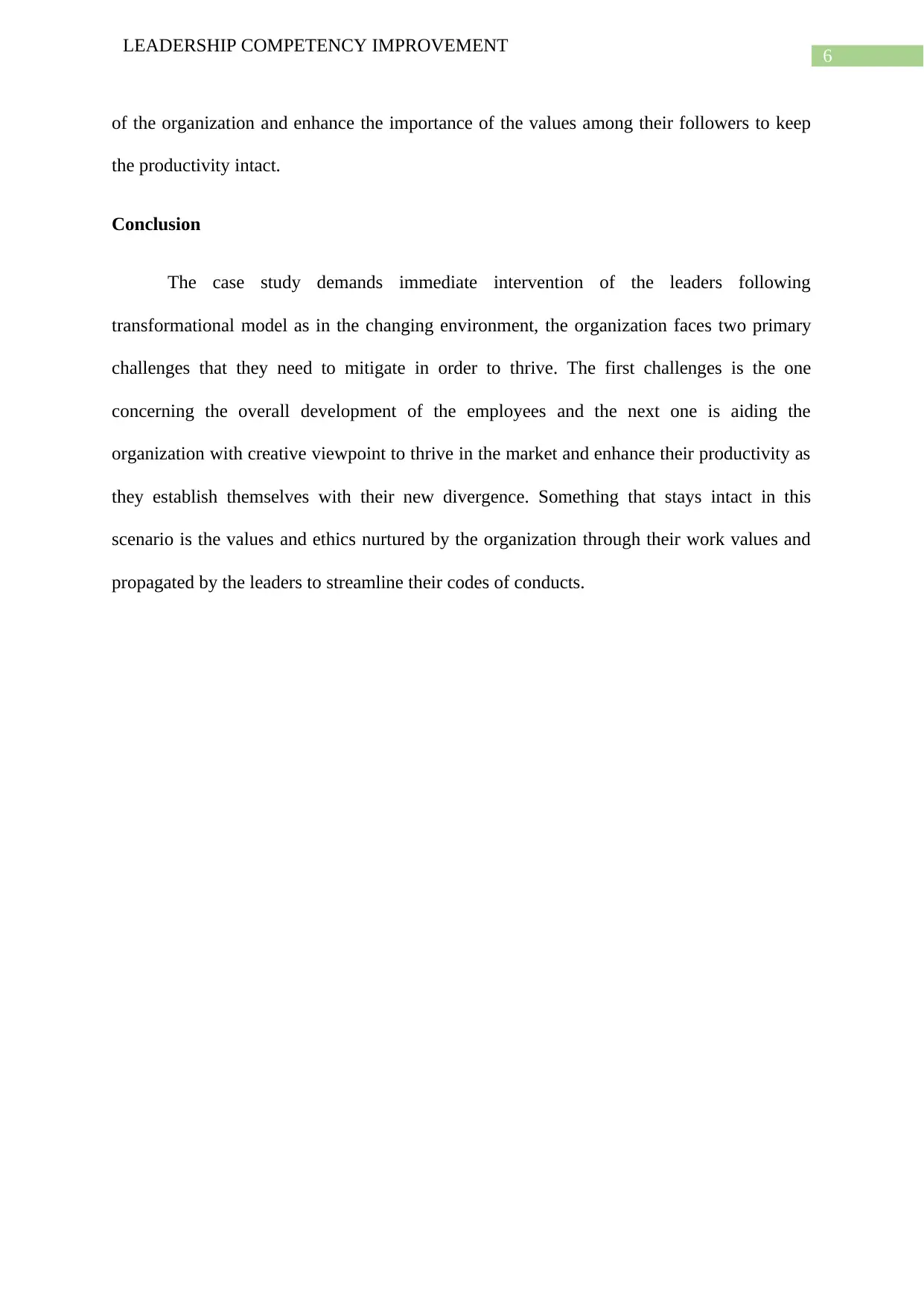
6
LEADERSHIP COMPETENCY IMPROVEMENT
of the organization and enhance the importance of the values among their followers to keep
the productivity intact.
Conclusion
The case study demands immediate intervention of the leaders following
transformational model as in the changing environment, the organization faces two primary
challenges that they need to mitigate in order to thrive. The first challenges is the one
concerning the overall development of the employees and the next one is aiding the
organization with creative viewpoint to thrive in the market and enhance their productivity as
they establish themselves with their new divergence. Something that stays intact in this
scenario is the values and ethics nurtured by the organization through their work values and
propagated by the leaders to streamline their codes of conducts.
LEADERSHIP COMPETENCY IMPROVEMENT
of the organization and enhance the importance of the values among their followers to keep
the productivity intact.
Conclusion
The case study demands immediate intervention of the leaders following
transformational model as in the changing environment, the organization faces two primary
challenges that they need to mitigate in order to thrive. The first challenges is the one
concerning the overall development of the employees and the next one is aiding the
organization with creative viewpoint to thrive in the market and enhance their productivity as
they establish themselves with their new divergence. Something that stays intact in this
scenario is the values and ethics nurtured by the organization through their work values and
propagated by the leaders to streamline their codes of conducts.
Paraphrase This Document
Need a fresh take? Get an instant paraphrase of this document with our AI Paraphraser
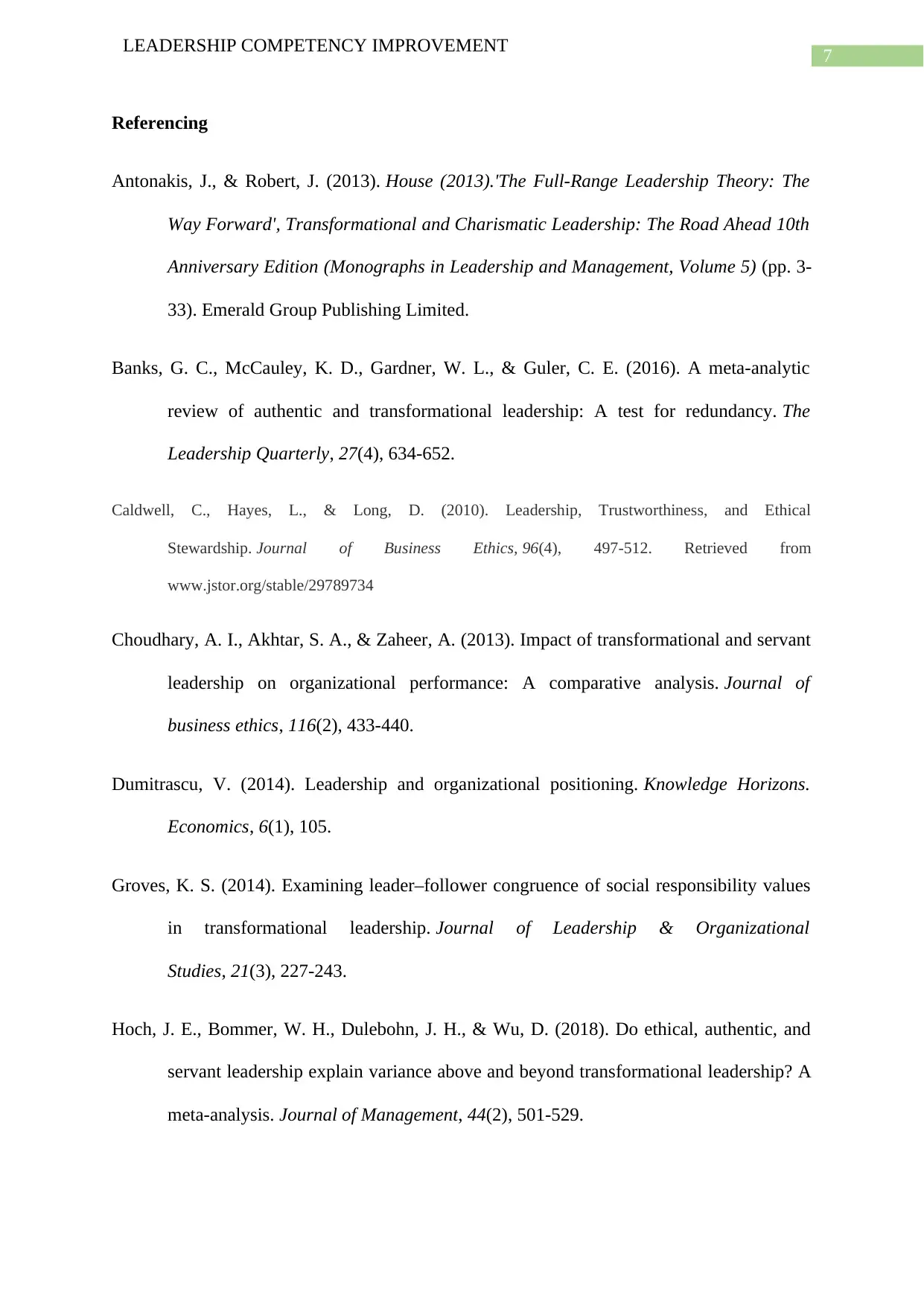
7
LEADERSHIP COMPETENCY IMPROVEMENT
Referencing
Antonakis, J., & Robert, J. (2013). House (2013).'The Full-Range Leadership Theory: The
Way Forward', Transformational and Charismatic Leadership: The Road Ahead 10th
Anniversary Edition (Monographs in Leadership and Management, Volume 5) (pp. 3-
33). Emerald Group Publishing Limited.
Banks, G. C., McCauley, K. D., Gardner, W. L., & Guler, C. E. (2016). A meta-analytic
review of authentic and transformational leadership: A test for redundancy. The
Leadership Quarterly, 27(4), 634-652.
Caldwell, C., Hayes, L., & Long, D. (2010). Leadership, Trustworthiness, and Ethical
Stewardship. Journal of Business Ethics, 96(4), 497-512. Retrieved from
www.jstor.org/stable/29789734
Choudhary, A. I., Akhtar, S. A., & Zaheer, A. (2013). Impact of transformational and servant
leadership on organizational performance: A comparative analysis. Journal of
business ethics, 116(2), 433-440.
Dumitrascu, V. (2014). Leadership and organizational positioning. Knowledge Horizons.
Economics, 6(1), 105.
Groves, K. S. (2014). Examining leader–follower congruence of social responsibility values
in transformational leadership. Journal of Leadership & Organizational
Studies, 21(3), 227-243.
Hoch, J. E., Bommer, W. H., Dulebohn, J. H., & Wu, D. (2018). Do ethical, authentic, and
servant leadership explain variance above and beyond transformational leadership? A
meta-analysis. Journal of Management, 44(2), 501-529.
LEADERSHIP COMPETENCY IMPROVEMENT
Referencing
Antonakis, J., & Robert, J. (2013). House (2013).'The Full-Range Leadership Theory: The
Way Forward', Transformational and Charismatic Leadership: The Road Ahead 10th
Anniversary Edition (Monographs in Leadership and Management, Volume 5) (pp. 3-
33). Emerald Group Publishing Limited.
Banks, G. C., McCauley, K. D., Gardner, W. L., & Guler, C. E. (2016). A meta-analytic
review of authentic and transformational leadership: A test for redundancy. The
Leadership Quarterly, 27(4), 634-652.
Caldwell, C., Hayes, L., & Long, D. (2010). Leadership, Trustworthiness, and Ethical
Stewardship. Journal of Business Ethics, 96(4), 497-512. Retrieved from
www.jstor.org/stable/29789734
Choudhary, A. I., Akhtar, S. A., & Zaheer, A. (2013). Impact of transformational and servant
leadership on organizational performance: A comparative analysis. Journal of
business ethics, 116(2), 433-440.
Dumitrascu, V. (2014). Leadership and organizational positioning. Knowledge Horizons.
Economics, 6(1), 105.
Groves, K. S. (2014). Examining leader–follower congruence of social responsibility values
in transformational leadership. Journal of Leadership & Organizational
Studies, 21(3), 227-243.
Hoch, J. E., Bommer, W. H., Dulebohn, J. H., & Wu, D. (2018). Do ethical, authentic, and
servant leadership explain variance above and beyond transformational leadership? A
meta-analysis. Journal of Management, 44(2), 501-529.
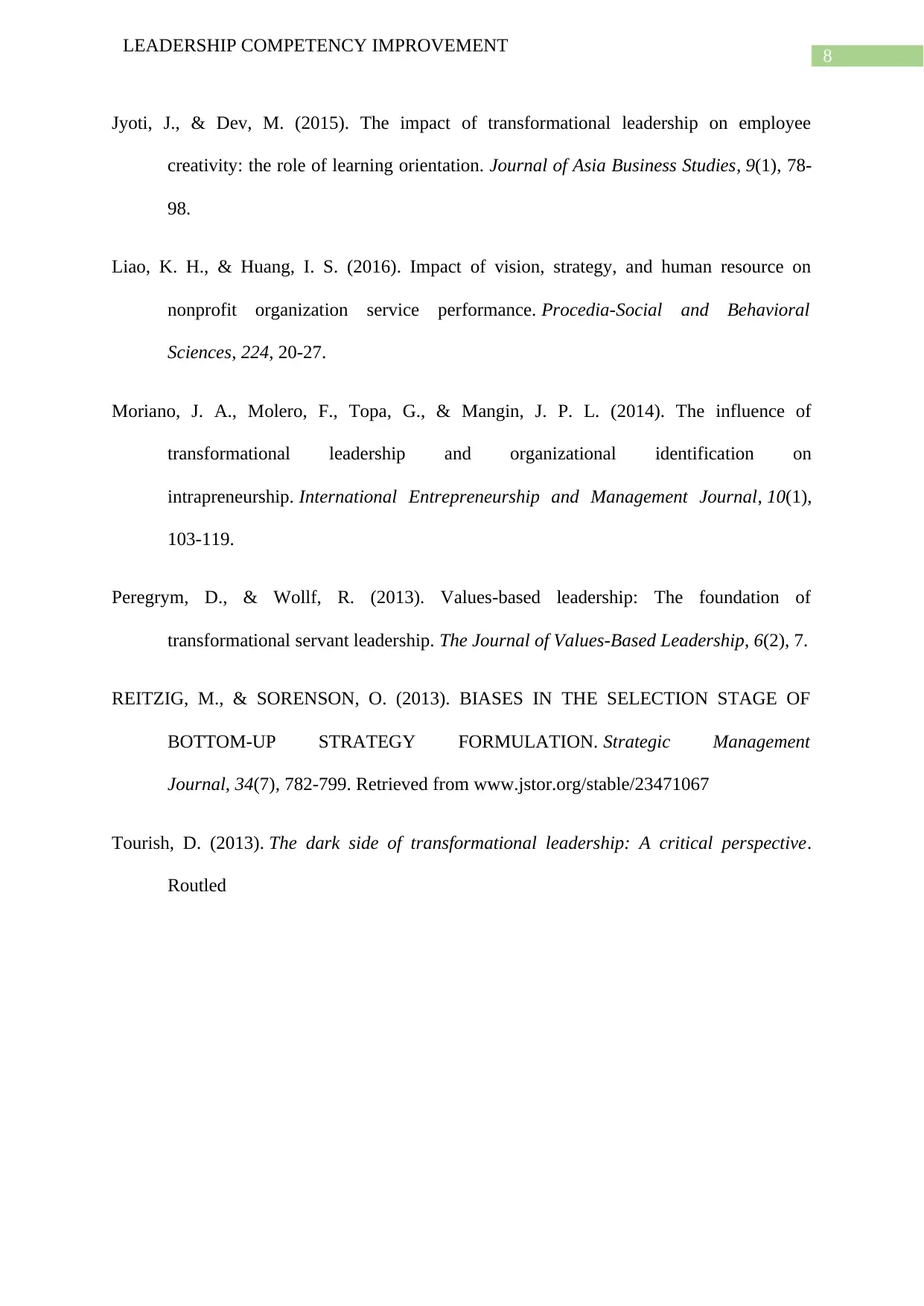
8
LEADERSHIP COMPETENCY IMPROVEMENT
Jyoti, J., & Dev, M. (2015). The impact of transformational leadership on employee
creativity: the role of learning orientation. Journal of Asia Business Studies, 9(1), 78-
98.
Liao, K. H., & Huang, I. S. (2016). Impact of vision, strategy, and human resource on
nonprofit organization service performance. Procedia-Social and Behavioral
Sciences, 224, 20-27.
Moriano, J. A., Molero, F., Topa, G., & Mangin, J. P. L. (2014). The influence of
transformational leadership and organizational identification on
intrapreneurship. International Entrepreneurship and Management Journal, 10(1),
103-119.
Peregrym, D., & Wollf, R. (2013). Values-based leadership: The foundation of
transformational servant leadership. The Journal of Values-Based Leadership, 6(2), 7.
REITZIG, M., & SORENSON, O. (2013). BIASES IN THE SELECTION STAGE OF
BOTTOM-UP STRATEGY FORMULATION. Strategic Management
Journal, 34(7), 782-799. Retrieved from www.jstor.org/stable/23471067
Tourish, D. (2013). The dark side of transformational leadership: A critical perspective.
Routled
LEADERSHIP COMPETENCY IMPROVEMENT
Jyoti, J., & Dev, M. (2015). The impact of transformational leadership on employee
creativity: the role of learning orientation. Journal of Asia Business Studies, 9(1), 78-
98.
Liao, K. H., & Huang, I. S. (2016). Impact of vision, strategy, and human resource on
nonprofit organization service performance. Procedia-Social and Behavioral
Sciences, 224, 20-27.
Moriano, J. A., Molero, F., Topa, G., & Mangin, J. P. L. (2014). The influence of
transformational leadership and organizational identification on
intrapreneurship. International Entrepreneurship and Management Journal, 10(1),
103-119.
Peregrym, D., & Wollf, R. (2013). Values-based leadership: The foundation of
transformational servant leadership. The Journal of Values-Based Leadership, 6(2), 7.
REITZIG, M., & SORENSON, O. (2013). BIASES IN THE SELECTION STAGE OF
BOTTOM-UP STRATEGY FORMULATION. Strategic Management
Journal, 34(7), 782-799. Retrieved from www.jstor.org/stable/23471067
Tourish, D. (2013). The dark side of transformational leadership: A critical perspective.
Routled
⊘ This is a preview!⊘
Do you want full access?
Subscribe today to unlock all pages.

Trusted by 1+ million students worldwide
1 out of 9
Related Documents
Your All-in-One AI-Powered Toolkit for Academic Success.
+13062052269
info@desklib.com
Available 24*7 on WhatsApp / Email
![[object Object]](/_next/static/media/star-bottom.7253800d.svg)
Unlock your academic potential
Copyright © 2020–2025 A2Z Services. All Rights Reserved. Developed and managed by ZUCOL.



